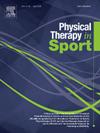血流受限运动后的运动诱导痛觉减退
IF 2.2
3区 医学
Q1 REHABILITATION
引用次数: 0
摘要
目的评估低负荷阻力运动伴血流受限(LL + BFR)后运动诱发的低痛觉缺失(EIH)的可重复性,以及运动后1小时后LL + BFR、高负荷阻力运动和对照干预后EIH的程度。DesignCrossover设计。SettingUniversity实验室。参与者15名女性,15名男性。主要观察指标:运动前和运动后0、15、30、45和60分钟,股直肌、腓肠肌和肱二头肌的压力阈值和耐受性。结果LL + BFR1和LL + BFR2在疼痛压力阈值和耐受性方面无显著差异(p = 0.211 ~ 0.741),提示LL + BFR术后EIH具有可重复性。LL + BFR可显著(p = 0.001-0.043)提高局部痛压阈值(1.57±1.21-0.98±1.48 Δkgf)和耐受性(1.98±2.65-0.83±2.15 Δkgf)至运动后1小时。高负荷阻力运动引起运动后0分钟疼痛压力阈值(1.69±1.74 Δkgf)和运动后0和15分钟耐受性(2.31±2.44 Δkgf)显著(p = 0.003-0.034)增加;分别为0.56±1.83 Δkgf),然后恢复到运动前的水平。随着时间的推移,LL + BFR引起腓肠肌的全身疼痛压力耐受性(0.77±0.88 Δkgf)以及肱二头肌的疼痛压力阈值(0.53±0.54 Δkgf)和耐受性(0.49±1.02 Δkgf)显著(p = 0.025-0.046)增加。结论sll + BFR可能是一种可重复、有效的疼痛管理干预,可产生延长的EIH。本文章由计算机程序翻译,如有差异,请以英文原文为准。
Exercise-induced hypoalgesia following blood flow restricted exercise
Objectives
Assess the repeatability of exercise-induced hypoalgesia (EIH) following low-load resistance exercise with blood flow restriction (LL + BFR) and the magnitude of EIH following LL + BFR, high-load resistance exercise, and a control intervention 1-h after exercise.
Design
Crossover design.
Setting
University laboratory.
Participants
15 females, 15 males.
Main outcome measures
Pain pressure threshold and tolerance of the rectus femoris, gastrocnemius, and biceps brachii pre-exercise and 0-, 15-, 30-, 45-, and 60-min post-exercise.
Results
There was no significant (p = 0.211–0.741) difference in pain pressure threshold or tolerance between LL + BFR1 and LL + BFR2 suggesting that EIH following LL + BFR is repeatable. LL + BFR elicited a significant (p = 0.001–0.043) increase in local pain pressure threshold (1.57 ± 1.21–0.98 ± 1.48 Δkgf) and tolerance (1.98 ± 2.65–0.83 ± 2.15 Δkgf) up to 1-h post-exercise. High-load resistance exercise elicited a significant (p = 0.003–0.034) increase in pain pressure threshold 0-min post-exercise (1.69 ± 1.74 Δkgf) and tolerance 0- and 15-min post-exercise (2.31 ± 2.44 Δkgf; 0.56 ± 1.83 Δkgf, respectively) then returned to pre-exercise levels. LL + BFR elicited a significant (p = 0.025–0.046) increase in systemic pain pressure tolerance (0.77 ± 0.88 Δkgf) of the gastrocnemius as well as pain pressure threshold (0.53 ± 0.54 Δkgf) and tolerance (0.49 ± 1.02 Δkgf) of the biceps brachii, when collapsed across Time.
Conclusions
LL + BFR may be a repeatable, effective pain management intervention that can produce prolonged EIH.
求助全文
通过发布文献求助,成功后即可免费获取论文全文。
去求助
来源期刊

Physical Therapy in Sport
医学-康复医学
CiteScore
4.50
自引率
8.30%
发文量
125
审稿时长
39 days
期刊介绍:
Physical Therapy in Sport is an international peer-reviewed journal that provides a forum for the publication of research and clinical practice material relevant to the healthcare professions involved in sports and exercise medicine, and rehabilitation. The journal publishes material that is indispensable for day-to-day practice and continuing professional development. Physical Therapy in Sport covers topics dealing with the diagnosis, treatment, and prevention of injuries, as well as more general areas of sports and exercise medicine and related sports science.
The journal publishes original research, case studies, reviews, masterclasses, papers on clinical approaches, and book reviews, as well as occasional reports from conferences. Papers are double-blind peer-reviewed by our international advisory board and other international experts, and submissions from a broad range of disciplines are actively encouraged.
 求助内容:
求助内容: 应助结果提醒方式:
应助结果提醒方式:


